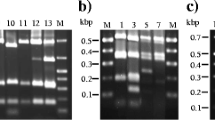Abstract
Bacterial counts on the liquid phase of an anaerobic, fixed-bed digester, treating a deproteinated, prefermented cheese whey substrate, were conducted on two different media under aerobic and facultative conditions. Average counts of 16.6×106 and 26.5×106 ml−1 were obtained on the two media, with the nutritionally poorer of the two media giving the highest average count. Seventy-five isolates from both media, incubated aerobically as well as in anaerobic jars, were obtained. These isolates as well as 13 reference strains were phenotypically characterized. The similarities between cultures were calculated using the similarity coefficient of Sokal and Michener [16]. The organisms were clustered using the unweighted pair group method, and the results presented as a simplified dendrogram. The isolates could be divided into 3 main groups: gram-negative fermentative rods, mainlyEnterobacter, Klebsiella, andCitrobacter, withKlebsiella as the predominant genus; gram-positive bacteria, mainly enterococci; and gram-negative nonfermentive rods of the generaPseudomonas, Alcaligenes, andAcinetobacter. All the enterobacteria and enterococci were able to produce acetic acid, an intermediate in methanogenesis.
Similar content being viewed by others
References
Bryant MP (1979) Microbial methane production: theoretical aspects. J Anim Sci 48:193–201
de Haast J (1982) Whey utilization versus pollution. S Afr J Dairy Technol 14:97–99
de Haast J, Britz TJ, Novello JC, Lategan PM (1983) Anaerobic digestion of cheese whey using a stationary fixed-bed reactor. New Zealand J Dairy Sci Technol 18:261–271
de Haast J, Britz TJ, Novello JC, Verwey EW (1986) Anaerobic digestion of deproteinated cheese whey. J Dairy Res 52:457–467
Forday W, Greenfield PF (1983) Anaerobic digestion. Effluent Water Treat J 10:405–413
Harrigan WF, McCance ME (1976) Laboratory method in food and dairy microbiology. Academic Press, London
Hobson PN (1973) The bacteriology of anaerobic sewage digestion. Process Biochem 8:19–25
Hobson PN, Shaw BG (1974) The bacterial population of piggery-waste anaerobic digesters. Water Res 8:507–516
Holdeman LV, Cato EP, Moore WEC (1977) Anaerobic laboratory manual, 4th ed. Virginia Polytechnic Institute and State University, Blacksburg, Virginia
Iannotti EL, Fischer JR, Sievers DM (1982) Characterization of bacteria from a swine manure digester. Appl Env Microbiol 43:136–143
Iannotti EL, Fischer JR, Sievers DM (1982) Medium for enhanced growth of bacteria from a swine manure digester. Appl Env Microbiol 43:247–249
Kistner A (1960) An improved method for viable counts of bacteria of the ovine rumen which ferment carbohydrates. J Gen Microbiol 23:565–576
Kotzé JP, Thiel PG, Toerien DF, Hattingh WHJ, Siebert ML (1968) A biological and chemical study of several anaerobic digesters. Water Res 2:195–213
Krieg NR, Holt JG (1984) Bergey's manual of systematic bacteriology. Vol. 1. Williams & Wilkens, Baltimore, pp 130–662
Sahm H (1984) Anaerobic wastewater treatment. In: Fiechter A (ed) Adv in Biochem Eng/Biotechnol 29:83–115
Sokal RR, Michener CD (1958) A statistical method for evaluating systematic relationships. Kansas University Science Bulletin 38:1409–1438
Toerien DF (1967) Enrichment culture studies on aerobic and facultative anaerobic bacteria found in anaerobic digesters. Water Res 1:147–155
Toerien DF, Hattingh WHJ (1969) Anaerobic digestion 1. The microbiology of anaerobic digestion. Water Res 3:385–416
Toerien DF, Siebert ML, Hattingh WHJ (1967) The bacterial nature of the acid-forming phase of anaerobic digestion. Water Res 1:497–507
Ueki A, Minato H, Azuma R, Suto T (1980) Enumeration and isolation of anaerobic bacteria in sewage digestor fluids: isolation of lactate utilizers. J Gen Appl Microbiol 26:15–24
Weber H, Kulbe KD, Chmiel H, Trösch W (1984) Microbial acetate conversion to methane: kinetics, yields and pathways in a two-step digestion process. Appl Microbiol Biotechnol 19:224–228
Zeikus JG (1980) Microbial populations in digesters. In: Stafford DA, Wheatley BI, Hughes DE (eds) Anaerobic digestion. Applied Science Publishers, London, pp 61–89
Author information
Authors and Affiliations
Rights and permissions
About this article
Cite this article
de Haast, J., Britz, T.J. Characterization of aerobic and facultative anaerobic bacteria from the liquid phase of an anaerobic fixed-bed digester treating a cheese whey substrate. Microb Ecol 12, 173–179 (1986). https://doi.org/10.1007/BF02011201
Issue Date:
DOI: https://doi.org/10.1007/BF02011201




